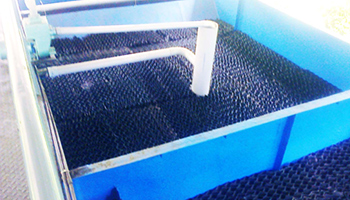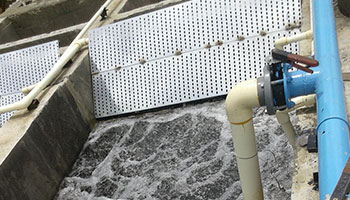MBBR (Moving bed biofilm reactor) as the name suggests is a high rate attached growth aerobic treatment system wherein the bacterial growth takes place on a inert PP media. MBBR process uses the floating type plastic media for the attached growth process. Treatment units based on MBBR are operating successfully worldwide, as the technology is rugged and simple to operate. Units can be pre-assembled for rapid on-site installation. The major advantages include a compact, efficient design (less than a half of conventional plants), low sludge generation, low odor and low visual impact, and simple maintenance requirements. Like SAFF process the basic principle of treatment is attached growth which is carried out on media surface which is extensively corrugated specialized structure. Sparkle offers various grades of MBBR reactor media i.e. cylindrical, Spiral, Spiral media, etc.
Advantage of MBBR process
- MLSS concentration is much higher than what is normally achieved in aeration system of ASP process.
- Higher loading of BOD on the media enables to reduce the aeration tank size. MBBR requires 60 % lesser tank volume as compared to activated sludge process.
- Based on attached growth process, where media is floating in aeration tank, hence it provides maximum surface area.
- MBBR system takes higher shock loads without reducing the plant performance because of large quantity of MLSS available inside the reactor.
- Rate of sludge generation is normally lesser as compared to conventional system.
- Life of MBBR system is long (about 10-15 years) as inert PVC media material is used. Non pressurized system.
- All these process produces better quality treated wastewater than conventional activated sludge process.
- Easily meets discharge norms.
- Space requirement is less. Treatment units can be accommodated in smallest available area.
- Treated waste water can be reused for various applications like: flushing in toilets, gardening, road washing, car washing, construction activities after softening treatment it can reused for cooling towers makeup etc.
- Odor problems, maintenance problems, are eliminated.
- High MLSS – Less Space required for the treatment.
- Due to use of diffused aeration power consumption is less. Small reactor size also helps to reduce power requirement, maintenance problems
- Treatment is principally based on most proven activated sludge process.
- MBBR process able to achieve 95-98% BOD reduction.
Due to above advantages the SAFF process is used commonly in package systems where compactness of treatment is key factor.

